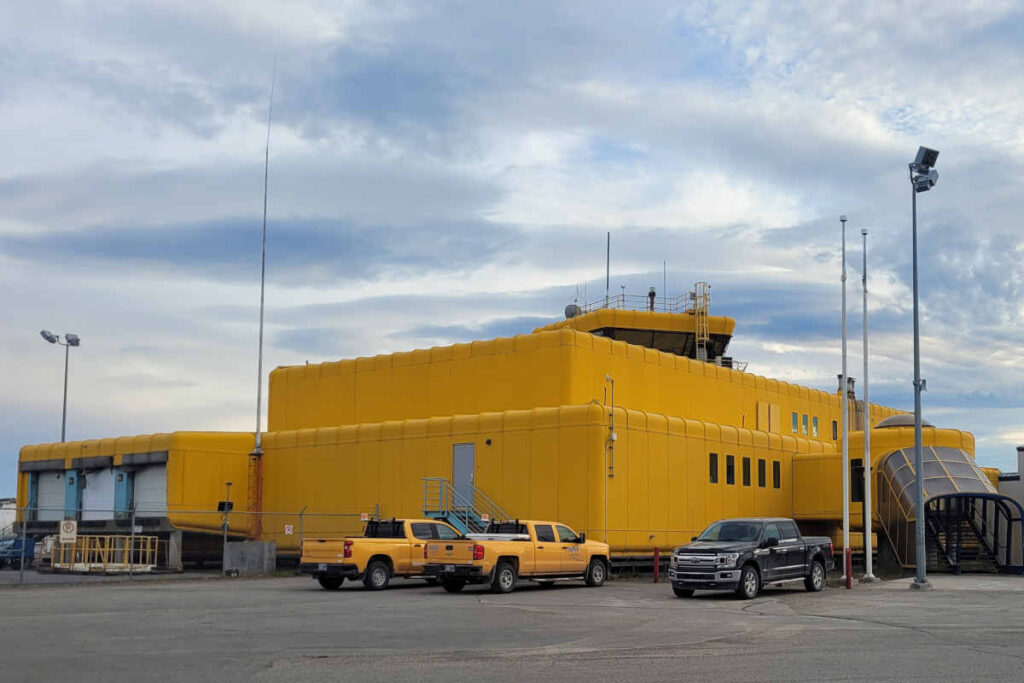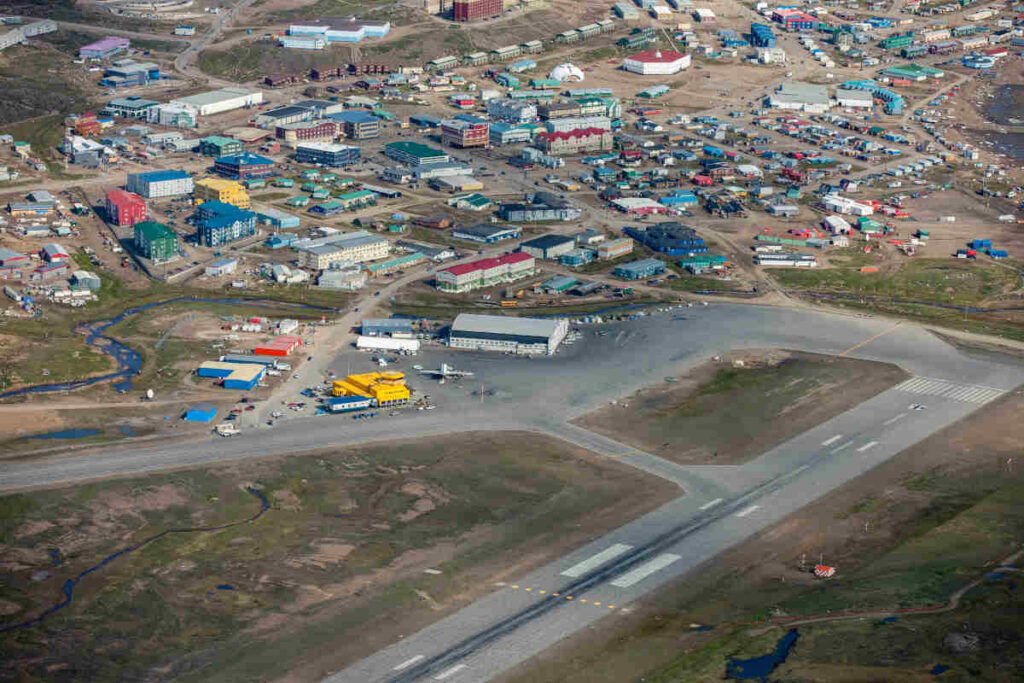
News
Air Traffic
Training
Look up, Inside NAV Canada’s training pipeline
For some the sky is the limit, to NAV Canadians it is just the beginning, By David Carr
January 31, 2023 By David Carr
 Kaitlyn Haynes is a recent graduate of the NAV CANADA Flight Service Specialist training program and now an active Flight Service Specialist based at Iqaluit, Nunavut. (Photo: NAV CANADA)
Kaitlyn Haynes is a recent graduate of the NAV CANADA Flight Service Specialist training program and now an active Flight Service Specialist based at Iqaluit, Nunavut. (Photo: NAV CANADA) Think air navigation and you immediately think airport control towers and people with binoculars and radios skillfully guiding airplanes onto and off runways from their glass-enclosed perch high above the airfield. But, like the proverbial iceberg, there is more action below the surface.
NAV CANADA plays a unique and critical role managing 18 million square kilometres of Canadian civil airspace and the North Atlantic oceanic airspace, one of the largest regions of airspace in the world. About 22 per cent of airplanes that appear on NAV CANADA’s radar will not land or take off from a Canadian airport.
The task of keeping such a large amount of airspace safe comes down to a highly integrated network of 42 air traffic control towers, seven area control centres (ACC), 54 airport advisory flight service stations, and five flight information centres, staffed by personnel with the right abilities, training and ongoing development. For anyone who wants to keep their feet on the ground while exploring a fast-paced career in aviation, NAV CANADA is an attractive and lucrative career destination.
“It’s an awesome job because it is different every single day, especially the weather,” says Kaitlyn Haynes, a recent graduate of the NAV CANADA Flight Service Specialist training program and now an active Flight Service Specialist based at Iqaluit, Nunavut. Haynes is responsible for aircraft flying in and out of the airport, briefing operators about traffic, providing hourly weather reports (including special bulletins during severe weather) and relaying clearances provided by ACCs. “If you’re interested in aviation, you also see a lot of cool airplanes.”
What distinguishes NAV CANADA from other companies in the aviation and aerospace sector is the requirement to get in the front door. No post-secondary education is necessary. Applicants need to be at least 18 years of age, a Canadian citizen or permanent resident with a high school degree or equivalency. “You don’t need an aviation background to be an air traffic services professional,” says Kaitlyn Turner, a Talent Acquisition Specialist at NAV CANADA. “Previous work experience isn’t a requirement because we provide the training. We’re all about competencies.”
This unique approach to recruitment gives the air navigation service provider access to a much larger talent pool, including individuals looking to course correct their careers after a few years in the job market. “There are high school graduates, people with a Master’s degree, former teachers and nurses. You get the full gambit,” Turner adds.
To ensure candidates possess competencies needed to take on responsibility for the safety of thousands of passengers and react calmly and professionally during an emergency, NAV CANADA puts applicants through an engaging screening process, including an introductory online assessment, computer-based evaluation at one of its centres and an interview with a manager and human resources professional. Successful applicants are assessed for careers in air traffic control, flight services or both, based on test results.
The company’s air traffic controllers direct airplanes either from the ‘cab’ of an ATC tower or on a radar screen at an ACC. Working with pilots operating all types of aircraft, from a helicopter or single-engine Cessna to the largest and most sophisticated passenger jets, an air traffic controller instructs pilots to climb, turn, descend and move safely, whether they are on the ground at an airport or thousands of feet in the sky. Air traffic controllers ensure aircraft maintain vertical, lateral or time separation, while following strictly defined rules, procedures, and regulations. Base annual salaries for qualified air traffic controllers range from $84,347 to $170,241.
Flight service specialists work out of flight information centres and flight service stations in some of Canada’s busiest cities and most remote sites. They play a critical role in assisting pilots before departure, during flight and at arrival, providing airport advisory services, delivering essential weather reports and hazardous meteorological conditions, and processing flight plans and itineraries. Additionally, they serve as a communications link between pilots, airlines, medevac operators, other NAV CANADA teams, and much more. Base annual salaries for certified flight service specialists range from $68,464 to $104,811.
NAV CANADA does not contract training to a third-party. All instruction is carried out in house using an industry-leading training model that involves working on NAV CANADA equipment with lessons delivered by learning specialists experienced in adult education. Unlike third-party training, the NAV CANADA model makes for a more seamless transition from classroom to workplace.
Students can expect to be placed in a class of anywhere from four to 12 people. There is both classroom-based learning and simulator training. Self-study, using resources and supports provided by NAV CANADA, is also a critical part of the training program. “It takes resilience and dedication, and many students make connections that last a lifetime,” Turner says.
Kaitlyn Haynes agrees: “The training is tough. You have to go from zero to 100 very quickly. It takes a lot of work and effort.” Haynes, who holds a university degree, chose a career with NAV CANADA to pursue her passion for meteorology (clouds especially) and likens the training to a one-year university course compressed into six months. “It’s very intense and very rewarding to get through. It is a career of a lifetime.”
Intense, yes, but NAV CANADA has built in safety rails to set students up for success. They are paired with a confidential ‘Thrive Peer’ to discuss their experiences while in training, express concerns or just ‘let off steam’, as well as access to a network of health and wellness specialists. “We have built in a tonne of supports in hopes that students achieve the highest levels of success possible,” Turner says.
Another advantage that separates NAV CANADA from other organizations is that students are paid to train and are entitled to company benefits and pension after successfully completing the first phase of the training program. “It’s a different approach,” Turner reflects. “It’s not like a regular training school where you pay to learn. We pay you to train with us.”
The global aviation industry is made up of millions of individual pieces moving at the same time. Air navigation service professionals are at the heart of this very complex system. For those with pre-set ideas of what air navigation is about (usually based on the movies) understanding the reality of how Canada’s air navigation service provider operates is a step out of the ordinary.
NAV CANADA was the first global air navigation service provider to be privatized. It is an independent, non-profit corporation that invests in the latest air-to-ground digital communications, radar and needed technologies to support its more than 40,000 customers worldwide, including mom-and-pop single airplane operators up to the world’s largest airlines.
Employees earn excellent salaries and benefits in a unique and rewarding work environment. In addition to air traffic control and flight services, NAV CANADA offers a host of career paths, including the installation and maintenance of critical technologies and infrastructure, corporate services such as supply chain and program administration, finance and audit, strategic planning and much more. As aviation aggressively bounces back from COVID-19, NAV CANADA offers Canadians a clear path to join one of the world’s most rewarding and innovative industries.
For students considering a career in aviation, there is no greater and more exciting window on the industry. If you’re ready to take your career to new heights, visit navcanada.ca/lookup.


